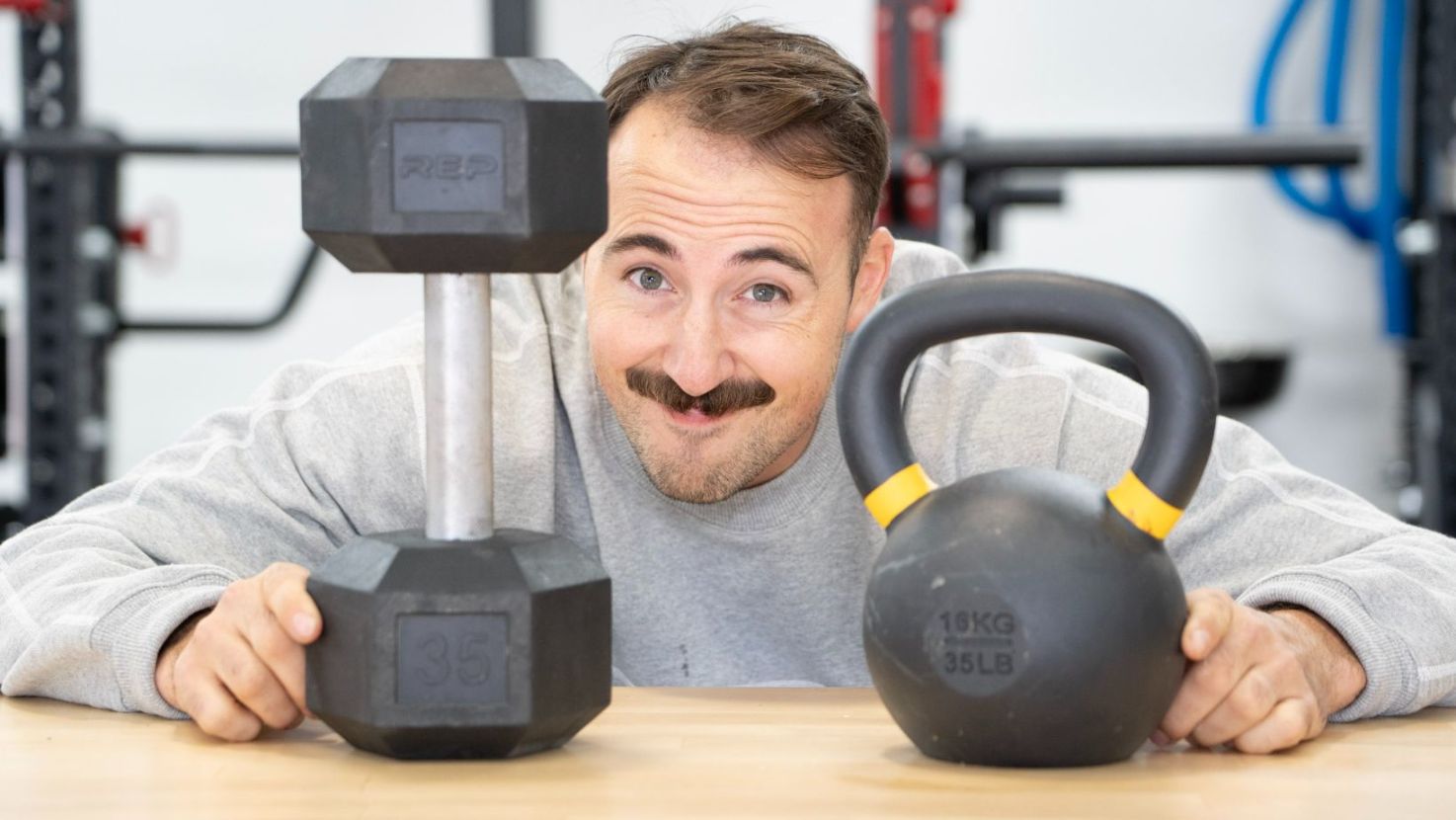We test and review fitness products based on an independent, multi-point methodology. If you use our links to purchase something, we may earn a commission. Read our disclosures.
Dumbbells vs. kettlebells is one of the longest-standing debates in the strength training community, and yet there doesn’t seem to be a clear-cut winner on which one is better. And maybe that’s because one isn’t necessarily better than the other…at least that’s what we think.
Dumbbells are certainly the more well-known piece of fitness equipment, and everyone from beginners to professional bodybuilders know how to use them to build muscle and strength. Kettlebells, on the other hand, are often cited as an easy way to get resistance training and cardio completed at the same time.
So which one is a better choice for your home gym?
At the end of the day, it’s much like apples vs. oranges. They’re both great for you and ultimately it’s going to come down to your preference, which might change from time to time depending on your fitness goals (just as you might pick oranges in the summer and apples in the fall).
Still unsure? We’ll dive a bit deeper into these two free weights to give you an idea of how they might benefit your weight training.
Why You Should Trust Us
Our team is filled with people who live and breathe everything fitness. We’re either personal trainers, or (in the case of myself) well on our way to becoming one. And it’s not just our job– it’s our passion. When we’re not writing about the best cross-training shoes or best adjustable dumbbells, we’re putting them to the test either to give you our honest thoughts about them or because we just like working out.
Dumbbells vs. Kettlebells Debate
We have our own thoughts on this debate, but we also wanted to get our readers’ perspectives. So we asked you if you could only have one set of free weights in your home gym, which would you choose? Dumbbells were the overwhelming favorite in an Instagram story poll.
We asked the same question in an Instagram post, and the results were a little tighter with people on both sides coming to their favorite free weight’s defense. Here’s some of our favorite responses:
The only prescription for a fever
Swing baby swing
You learn something new every day
Shots fired
Another great option, but that’s another story.
Dumbbells & Kettlebells Breakdown
Benefits of Dumbbells
It’s a good idea to understand why some people might prefer dumbbells over kettlebells, and vice-versa. And for that we need to understand what’s so appealing about them.
Dumbbells are probably most commonly used for growing biceps, but if that’s the extent of your experience with them, then you’re missing out. They can be used for lower-body training by doing lunges, and for cardio by grabbing the heaviest pair you can find and doing farmer’s walks.
There’s many benefits to using them, but here are just a few.
Ease of Use
As we mentioned before, dumbbells are widely-recognized even by people who don’t consider themselves fitness enthusiasts. One reason for that might be because humans have been lifting them for thousands of years. The dumbbell can be traced back to the 5th Century B.C., when Ancient Greeks were using them in the Olympic Games (which looked a little different than what we see on TV today).
Back then, they were oddly-shaped stones with handles on them, so it’s safe to say dumbbells have evolved over the centuries. And though their appearance has changed (thankfully), their purpose hasn’t–they’re still used to help people get stronger and build muscle to look bigger.
Dumbbells have been a part of popular culture for a long time. They’ve been used in physical education classes for hundreds of years, and there’s even dumbbell baby toys that let your child hit a bicep curl or overhead press before they can talk.
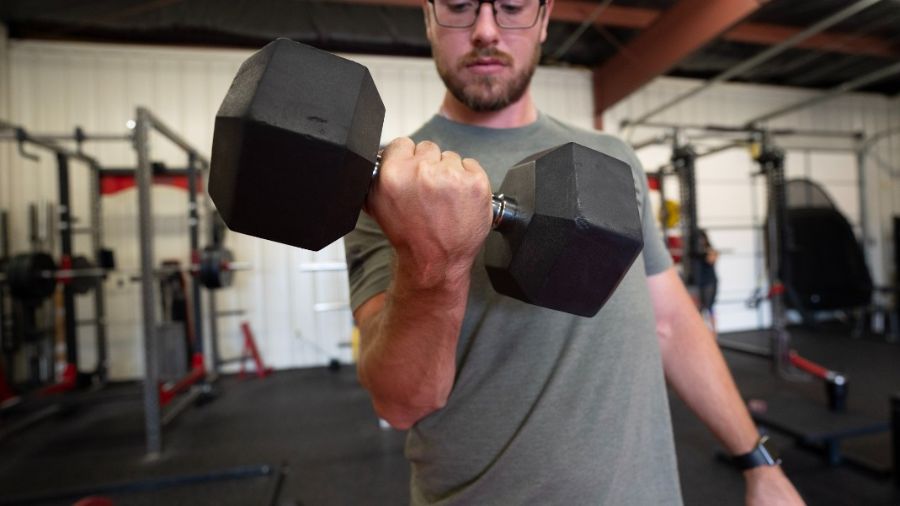
As a result, you could probably hand someone who’s never worked out before a 10-pound dumbbell and they could probably figure out how it works. You might have to tweak their form a little bit but it won’t take them long to get the point. The same can’t be said for many other weightlifting tools (like kettlebells).
People sometimes hesitate to start working out because they’re intimidated by the equipment and aren’t sure how to use it. So dumbbells’ ease of use can help break that barrier and make lifting more approachable.
Works Your Muscles and Stability
It’s true that dumbbells are great for isolation exercises, or moves that target a specific muscle group rather than multiple, which is what compound exercises like the bench press and deadlift are for. But dumbbell exercises can also be a great way at hitting different parts of the body at once…or so says science.
Dumbbell chest presses have actually been found to recruit more muscles than the standard barbell bench press or Smith machine bench press. In other words, more muscle fibers are activated when doing a dumbbell chest press. Researchers conducted electromyographic tests (a way of looking at the electrical activity of skeletal muscle) on people who performed all three moves.
The results? The lifters were not only able to perform more dumbbell chest press reps, which leads to more muscle, but there was also significantly more bicep activity than any other move. This has been proven in multiple studies conducted on different athletes.
This is because the weight of a barbell is steadier than a dumbbell, since the weight is more evenly distributed. That’s why someone who can bench press 300 pounds won’t necessarily be able to press two 150-pound dumbbells (yes, those exist).
Your arms are working harder to hold the weights during the latter, and unless you do moves that target specific muscles you’ll be hard-pressed to complete a single rep.
That’s why powerlifters and strongmen often utilize dumbbells to pinpoint weak areas in their arms and strengthen their stabilizer muscles. Stronger stabilizer muscles mean they’ll be able to hold heavier weights for longer periods of time.
Reduced Injury Risk
You can injure yourself with just about any piece of equipment if you don’t know how to use it properly, but dumbbells are probably your safest bet, next to machines, to reduce your injury risk.
Take the aforementioned bench press vs. chest press example. If you’re struggling to get the weight up with a barbell there’s a risk of dropping it on yourself (assuming you’re not using a spotter, which you should be) and that can lead to serious injury.
With a dumbbell chest press, the weights aren’t directly above your chest or face so if you can’t finish the rep you can drop them and they’ll fall to the ground next to you. They’re also generally easier to grip than kettlebells, which have a thicker handle, so there’s less chance of you flinging them around the gym.
Beyond that, dumbbell exercises can strengthen your stabilizing muscles and decrease any imbalances, such as one bicep being bigger or stronger than the other, which also reduces your overall injury risk.
It should be noted that kettlebells are also capable of doing all these things, too.
Benefits of Kettlebells
It goes without saying, but kettlebell exercises offer much of the same benefits that dumbbell training does: they help strengthen stabilizer muscles, correct imbalances, and can make you stronger to help you lift heavier weights. Kettlebell swings are just the tip of the iceberg when it comes to these versatile free weights.
With kettlebells becoming more and more popular every year, let’s take a look at some of the reasons why they’re taking the fitness world by storm.
RELATED: Free Weights Workouts
More Bang for Your Buck
If you’re tight on time and need a full-body workout in just a few minutes, or lack space and need a type of weight that can get multiple jobs done, kettlebells are the answer to your problem. In fact, Russian strongmen created these cannonball-shaped weights to work on strength, flexibility, and endurance all at the same time. Their versatility is still beloved by those in the bodybuilding and CrossFit communities today.
But just how effective are they at doing all these jobs? Well, a study sponsored by the American Council on Exercise (ACE) found that you burn as many calories during a 20-minute kettlebell workout, consisting of swings and snatches, as you do running a 6-minute-per mile pace for the same amount of time.
It also produced a similar heart rate and oxygen consumption (how much oxygen you use in a minute) as running. “The only other thing I could find that burns that many calories is cross-country skiing uphill at a fast pace,” lead researcher John Porcari told ACE.
With kettlebells, you have the added benefit of resistance training because you’re lifting heavy weights (something you can’t get from cross-country skiing or running). And moves like the swing or cleans also help you develop flexibility and balance.
Kettlebell training is also a great way to get a full-body workout since many of the moves, like the goblet squat or Turkish get-up, require you to use your upper and lower body simultaneously.
Full-body workouts are great because you can shorten the length of your workouts, as well as how often you workout during the week, since you’re hitting every part of your body in one go.
Dumbbells can also be used for metabolic conditioning, but their design makes it a little harder to do some of the moves you can do with a kettlebell.
RELATED: Best Dumbbell Exercises
Helps You Get a Grip (Strength)
Think about how many things have to hold onto throughout your day, from a loaded barbell to your grocery bags. There are tons of exercises dedicated to increasing your grip strength, which ensures you won’t drop the bar when you’re going for that next PR, and many of them can be done with a kettlebell.
If you’ve ever looked at, or put your hands on, a kettlebell handle, you probably noticed it’s thicker than a dumbbell or barbell. This makes it a little more challenging for you to hold onto it as you swing it, or go for a clean. And what happens when you continually challenge yourself at something? You get better at it over time.
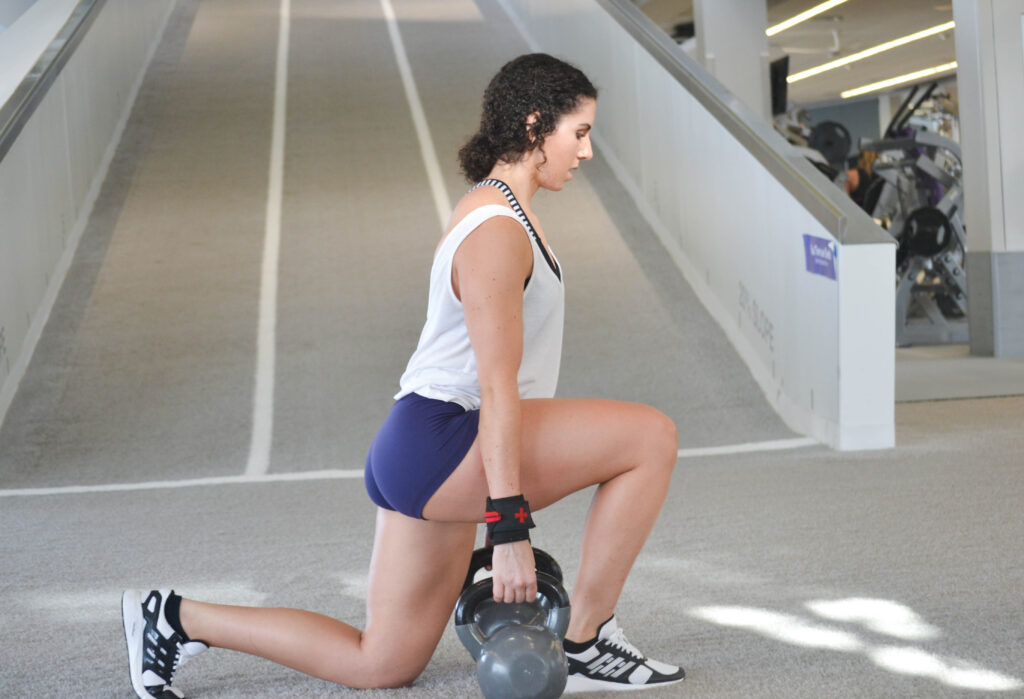
Another aspect of the kettlebell that helps increase your grip strength is the smooth texture of the handle. This is in contrast to the knurling you find on some dumbbells (not all have this feature) and barbells that’s designed to increase the friction between your hands and the type of weight you’re holding.
Knurling is good if you want to complete a rep without dropping anything, but again if you’re looking to get a stronger grip you want something that won’t do half the work for you. This is why people who use dumbbells often use Fat Gripz to increase their grip strength.
Now, the flip side of this coin is if you don’t have a good grip on your kettlebell handle it could get some frequent flyer miles across your gym. So make sure you’re not swinging close to anything fragile if you’re not too confident in your grip.
Functional Training and Physical Therapy
Most exercises are a form of functional training––deadlifts teach you how to properly lift heavy objects and squats train the muscles you use to sit up and down every day. In the same way, kettlebells have real world applications because of their shape and the fact that their center of gravity is further from your hand than a dumbbell.
Dr. Ben Fung, a physical therapist who wrote his thesis on the benefits of kettlebells, noted how objects like suitcases, bags, buckets, and more have the same offset center of gravity, and that kettlebell training could teach proper lifting mechanics for those objects and more.
Furthermore, he says in an online article, kettlebell swings address lower-body extension, core stabilization, scapula retraction, and shoulder flexing at the––all movements we use throughout our day and in the gym.
When it comes to the lower-body, the kettlebell swing hits all the muscles in the posterior chain: your glutes, hamstrings, calves, and erector spinae (the muscles that run vertically to your spine). A strong posterior chain leads to better posture, athletic performance, and increases your explosiveness during dynamic movements.
Functional training is vital for everyone, but it’s even more important for people recovering from an injury or surgery. Kettlebells, Fung says, target the muscle fibers athletes often damage and can be an easy way to strengthen them to prevent future injuries.
Differences between Dumbbells and Kettlebells
Obviously, one of the biggest differences between dumbbells and kettlebells is the shape. That has wider implications when it comes to the center of gravity and how the weight is dispersed.
With dumbbells, the weight is evenly distributed on both sides of the weight and a kettlebell’s weight sits below the handle. So when you’re doing something like a lateral raise, you have to work harder to stabilize a kettlebell because you’re working harder against gravity due to its shape, whereas it’s not quite as much of a challenge with dumbbells.
One of the other big differences is the handle. A dumbbell handle is only wide enough to fit one hand, whereas a kettlebell handle can fit two (depending on your hand size). The kettlebell handle is better suited for things like swings, though you can do it with a dumbbell––it might be a little more challenging is all.
Weight increments also vary between the two, and to explain why we need another quick history lesson. When kettlebells were first created in Russia they were weighed using a unit of measurement called a “pood,” which is 16 kilograms (or 35 pounds).
So the weight increments for kettlebells were made in conjunction with the pood, and kettlebell manufacturers still abide by that even though the pood is no longer used in Russia or anywhere else.
As a result, kettlebell increments jump anywhere from 4-8 kilograms (9-18 pounds), whereas dumbbell increments tend to jump 2.5 or 5 pounds.
It’s a little easier to progress with dumbbells because you can go from curling a 35-pound dumbbell to a 40-pound one quicker than you could working with a 53-pound kettlebell to a 62-pound one.
Kettlebells vs. Dumbbells, Which are better?
We’re still in the “It Depends” camp when it comes to dumbbells vs. kettlebells. We polled the fitness team here at Garage Gym Reviews to see what they thought and the team was fairly split.
At the end of the day, there’s a ton you can do with both and it’s going to depend on what you feel comfortable with. For example, our staff writer Amanda Capritto is team kettlebell except when it comes to snatches (because wrist bruises are a thing), whereas I’m team dumbbell until it comes time to do shoulder presses (I like the range of motion a little better).
Our fearless leader, Coop, personally finds dumbbells more versatile than kettlebells, but he’s still a fan of kettlebells.
A good way to find out which one works for your needs is to…well, try them both out. Dedicate a few weeks to training with both and see which gets you better results and feels better on your joints.
Who Should Use Dumbbells:
- People looking to strengthen stabilizer muscles used in powerlifting
- Anyone who needs to work on isolation exercises
- Anyone new to weight training who needs to practice their form
Who Should Use Kettlebells:
- Anyone who wants a quick workout that combines resistance training and cardio
- People who are recovering from injury or surgery
- Anyone who wants to improve their grip strength
Types of Dumbbells
The dumbbells you see in most commercial gyms aren’t the only type that are out there. Other variations possess their own advantages, depending on your training goals, so it’s important to know what’s on the market.
Fixed Dumbbells
These are the dumbbells most people are familiar with––a weight with a handle and two lumps at either end. These can be made of steel, rubber, chrome, and many other materials.
There are fixed round dumbbells, where the weight on either end of the handle is shaped like a circle, and fixed hex dumbbells, which have a hexagonal head on either side. Round shaped dumbbells are great for most moves, but if you want to do floor work you’ll want to find a hex dumbbell because those won’t roll.
Adjustable Dumbbells
These are popular among home gym owners for a simple reason: they replace several pairs of dumbbells with just one piece of equipment. When looking for an adjustable dumbbell, you want to see how heavy they go up to (some only get up to 50 pounds, while others can reach 150), the material they’re made of (some have plastic casing that can crack over time), and the ease of adjustment (some lower-quality models have a dial that gets stuck quite frequently).
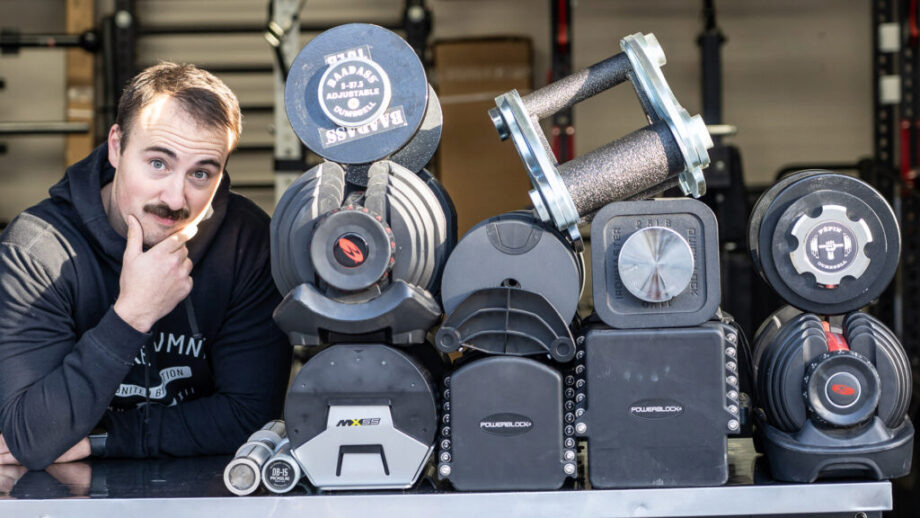
Loadable Dumbbells
So this isn’t a dumbbell per se, but rather a small barbell with sleeves on either side where you can load Olympic or bumper plates to create your own dumbbell. So they’re a great option for anyone who owns plates already but might not have a dumbbell set because you can make it as heavy as you want, depending on the sleeve size.
Types of Kettlebells
Just like dumbbells, you’re going to find a variety of kettlebells on the market and it’s important to know what to look for.
Standard
These are your run of the mill kettlebells. They’re usually made with iron or steel, and are either bare or coated in another type of material, such as the Rogue e-coat kettlebell, to protect the weights (and your floors and walls in case of accidental slippage). The size of the kettlebell will change the heavier it gets, as will the kettlebell handle.
Competition Kettlebell
Kettlebells used in home and commercial gyms differ from those used in CrossFit or other sporting events that feature kettlebells. What’s the difference? Well, a competition-style kettlebell always has a 5.5-inch base diameter, 35 mm wide handle, and 11.1-inch height whereas a standard one has a 33 mm handle, regardless of how heavy they are. This makes them a great choice for anyone with bigger hands.
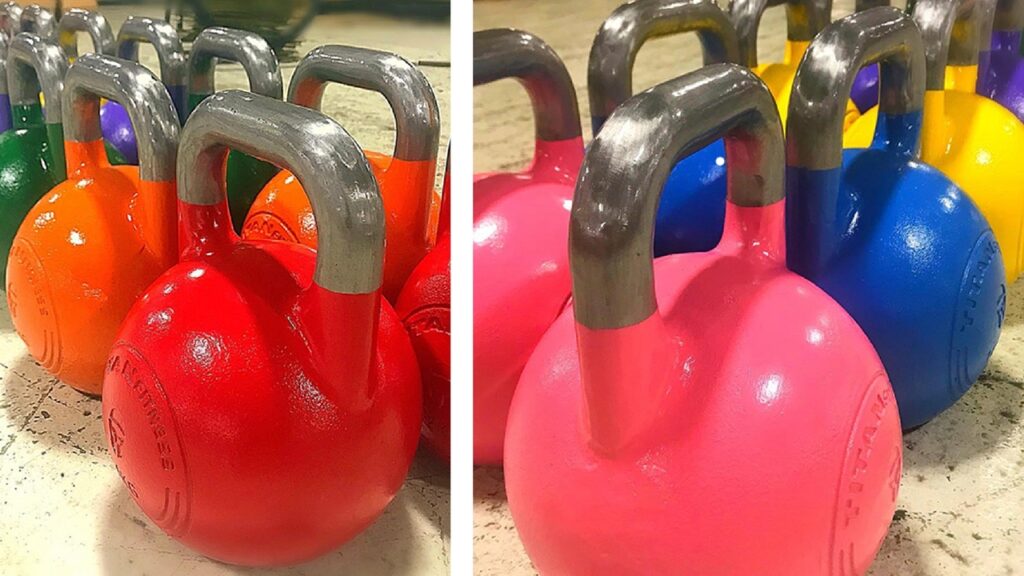
Adjustable Kettlebells
Like adjustable dumbbells, adjustable kettlebells help home gym owners save on space by replacing several weights in one. The one concern with popular adjustable kettlebells is the handle is sometimes made with plastic, meaning it’s even harder to ensure a good grip especially as you sweat during a grueling workout. Companies like Bowflex specialize in these types of adjustable weights.
Dumbbells vs. Kettlebells FAQs
Are kettlebells just as good as dumbbells?
It’s not that one is necessarily better than the other, but there are some areas where a dumbbell might be a better pick than a kettlebell, and vice-versa. Dumbbells are typically used for strength training, and kettlebells are usually used for metcon workouts. But that doesn’t mean you can’t switch them up every now and then.
Are dumbbells easier than kettlebells?
Because the weight is more evenly dispersed in a dumbbell, beginners might find them easier to work with than a kettlebell, which has an offset center of gravity.
Can you substitute a dumbbell for a kettlebell?
Yes, but because the weight sits below the handle some movements might be more challenging with a kettlebell than a dumbbell. Also, a kettlebell might be a little more challenging to hold onto because of its thicker handle.
Further reading

Dumbbells vs. kettlebells is one of the longest-standing debates in the strength training community, and yet there doesn’t seem to be a clear-cut winner on which one is better. And maybe that’s because one isn’t necessarily better than the other…at least that’s what we think. Dumbbells are certainly the more well-known piece of fitness equipment, and everyone from beginners to professional bodybuilders know how to use them to build muscle and strength. Kettlebells, » Read more about: Dumbbells vs. Kettlebells: The Battle for Free Weight Supremacy » Read more

If you’re weighing steady-state cardio vs HIIT workouts, here is everything you need to know. Read more

Our Evie Ring vs Oura Ring comparison breaks down everything you need to know about two popular fitness trackers so you can pick the right one for your finger. Read more

If you've ever been curious about how body fat can impact your health and fitness, you'll want to check out our expert guide to body fat percentage. Read more

